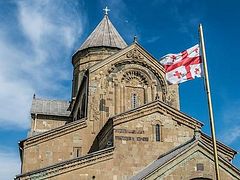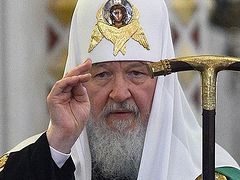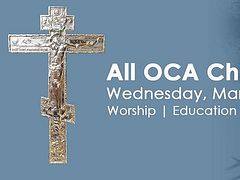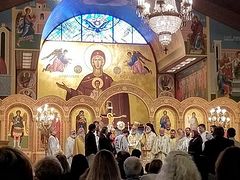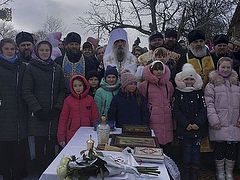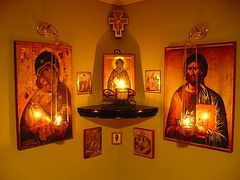At the time of the COVID-19 pandemic, the secular authorities have implemented “social distancing” as one of the crucial measures in the fight against the spread of the virus. One of the measures of social distancing, other than locking down pubs, nightclubs and cinemas was also to shut down the churches. Only “essential businesses” are allowed to stay open, and those apparently include bottle shops, beauty and nail salons, but not places of worship.
It seems that the secular government has quickly evolved into a secularist regime—a regime that is affecting the Church, an organism, as a form of infection that is spreading and causing disease. Social distancing is not helpful here, but spiritual distancing might be.
In fact, when we talk of social distancing, it should be mentioned that the ecclesial authorities introduced these measures before the secular, but under a different name—Great Lent.
Social distancing for spiritual healing
For centuries Great and Holy Lent was and still is a means of intense social distancing for Orthodox Christians. The Lenten social distancing is practised through a deepened ascetical life. When one is observing Lent, he or she is not supposed to be spending their time in social gatherings, let alone parties and worldly celebrations. One should withdraw from polemics, social networks, passive TV watching, etc. Lent is not just avoiding foods that may contain animal products; it also includes fasting from “empty words”. In other words, one should even avoid conversations that are not helping our salvation. Anything that is not contributing to our deification, anything that is taking our attention from the deep internal urge to come to God is in a sense breaking of the rule of Lent.
Being attentive and spiritually watchful is the actual goal of any fasting period. Abstaining from certain foods and social gatherings does not transform people into saints, it merely offers them an opportunity to turn down the volume of this world’s noise in order to hear, loud and clear, the call from God to join Him. Then it is up to us to answer that call and to commend ourselves and one another and our whole life to Christ our God. This would be the noetic communion with Christ to which we are all equally called—clergy and laity, monastics and city-dwellers.
One of the earliest kinds of social distancing in the Church was the appearance of the monastic movement in the fourth century. Saint Anthony, the father of all monks, used to say, “'Just as fish die if they stay too long out of water, so do monks who wander outside their cells or pass their time with men of the world lose the intensity of inner peace. So like a fish going towards the sea, we must hurry to reach our cell, for fear that if we delay outside we will lose our interior watchfulness.” But he was not a misanthrope; he also said, “Our life and our death is with our neighbour. If we gain our brother, we have gained God, but if we scandalise our brother, we have sinned against Christ.” He was practicing healthy social distancing while rejecting spiritual distancing. He knew that Christian love for each other could be advanced through prayer.
When the deserts became crowded, some of the fathers took social distancing to the next level, literally. They picked themselves up, built tall columns, climbed up and spent their lives as stylites. They showed much concern for the spiritual development of the people that were looking for God, but none for matters of the world. Not even the elements of weather, sticks and stones that might come their way would concern them in their every day life, as their attention was fully on the eternal life. Paradoxically, their social distancing attracted many people to them so they were not devoid of social life, but they transformed it through their own ascesis. They acted as spiritual lighthouses helping those fighting the ocean storms in the world to find save havens.
A spiritual retreat amongst the ruins
An Orthodox Christian today is also called to climb up a rock, a cornerstone on which the Church is built, above the worldly distractions, and focus on theosis. To build pillars out of the debris of the civilization ruined by the revolution against God and stand as a firm an-thropos, looking up. And when this proves to be a bit too hard for city-dwellers, the Church offers us the period of Lent as a spiritual retreat. Suddenly the liturgical life changes its rhythm, we are directly confronted with our separation from God, and the nature of the Church as a spiritual hospital is exposed in all its glory. Even the most superficial and traditionalist visitors of the Church are exposed to Orthodoxy as a divine method of the healing of the soul.
The mystical atmosphere of evening Liturgies of the presanctified Gifts, the weeping Canon of Saint Andrew of Crete, the Great Lenten vespers with many prostrations and begging of forgiveness, reveals the abundance of spiritual treasures that are distributed to those who give themselves over to Christ. The Church picks us up and carries us, like the Ark, through the surging seas. Participating in Great Lent through fasting, prayer and the sacraments reveals to us that we are a caravan traveling through the desert, and the oasis in our sight. We are carrying the Cross and already we anticipate the resurrection.
The only way out of this passionate path towards the Golgotha is through the triumph of Pascha—the Passover. Behind us are “Pharaoh and his soldiers”, in front of us is the “sea of temptations”. If we go back we are facing death in the Egyptian slavery, which is experienced today in the enslavement to banks, jobs, careers and mortgages. If we run ahead of the caravan of the New Israel, we separate ourselves from the Church, and we face death in the surging sea of the worldly temptations and distractions, experienced in peer pressures and social anxieties. This is where we find ourselves today, as the government is locking up the Churches.
The Liturgical rhythm of the Lent is broken and the New Israel, the Laity, the People of God, is in distress. People are calling their priests to ask how will they confess, how will they come to Church to light their candles, to offer their prayers, and above all, how will they partake of the Holy Eucharist. The priests as good shepherds are trying to save their flock, to keep the community together, to care for their spiritual needs but at the same time not to put them in danger. On the one hand, not to put them in a spiritual danger by destroying the fruits of their ascetical efforts, but also not to put them in harms way in the physical sense by exposing them to either contracting the disease or breaking the law of the land.
One of the first and most obvious temptations is the communion of Orthodox Christians from one cup and with one spoon. Divergent voices from the Church are not helping here. Some are calling the people to attend, the others are asking them to stay away, a third are asking if there are other ways of communing; perhaps different chalices and different spoons. To cut the long story short, the real question that is being asked here is: Can one die because of Holy Communion? The answer is: Yes. The holy apostle Paul teaches (1 Cor. 11:27-32) that those who are partaking of the mysteries without discerning the Body and Blood without examining themselves are getting weak, ill and even dying. Not because of contamination of the spoon, but because of lack of faith that the spoon actually is, λαβίς (Is 6:6). However, the most important question is, can one live without the Eucharist? And the answer is: No (John 6:52-59). To this day, a hard saying for many (John 6:60).
Some believe that modern technology can be used to overcome this conundrum. A popular trend among these is live streaming of the Holy Liturgy celebrated by a priest and a chanter alone. Admittedly, recordings and Internet communication can be valuable but there are limits. One of these limits, that cannot possibly be broken, is the Holy Liturgy.
Televised liturgies are not big news any more, at least not in the Orthodox countries. And they are not always completely unjustified. Even before television, the Orthodox Church had a so-called “Teaching Liturgies” that would be celebrated from time to time. At these Liturgies the proskomedia would be performed at the naos, for the People of God to see, certain parts would be explained, or a printed explanation would be distributed to the congregation. It is a way of practical catechization. Television simplified this process with a commentator, usually an academic theologian and an ordained priest, who would explain the parts of the Liturgy and its meaning to interested viewers.
The first problem with live streaming the Liturgy is that it is breaking the Disciplina Arcani. Not everything that is being said and done during the Liturgy is meant to be for everyone. The Liturgy is divided in three parts, the proskomedia (preparation), the Liturgy of the Catechumens (awaiting initiation) and the Liturgy of the faithful (those who are partaking in the Mystery). Every live stream should be stopped as soon as the Liturgy of the Catechumens is finished. The edifying aspects are concluded, the invitation is given, and the call went out. The rest is for those who are answering the call. It might seem unreasonable to the outside world, but the Church and the world are not using the same mind. For since in the wisdom of God the world through its wisdom did not know him, God was pleased through the foolishness of what was preached to save those who believe (1 Cor. 1:21).
One might argue that this problem is overcome by private live streams to specific groups of faithful who generally participate but are momentarily prevented by government lockdowns of Churches. However, there is a second problem with virtual Eucharistic gatherings. Namely, by nature it cannot be a true Eucharistic gathering without physical presence at the same time at the same place.
Firstly, one cannot receive the Body and Blood of Jesus Christ, which is a defeat of the purpose of the whole service. Secondly, the Liturgy by its name is a public service (litos ergos) and cannot be celebrated privately. Thirdly, the Holy Mystery of Liturgy is a relational reality where all are invited to gather together at one place (epi to auto). Following the Liturgy over a live stream with a sense of participation is a dangerous self-delusion (prelest) to which one should not be exposed by the very person that should take care of one’s spiritual health, i.e. the priest. The spread of such trend can be seen as a spiritual virus, a confusion of social distancing with spiritual distancing.
As William Inge once famously said, “Whoever marries the spirit of this age will find himself a widower in the next”. We are not the first generation whose Churches were locked by “Caesar”. Did our grandparents demand live streams? How did we survive the Ottoman period? Who taught our forefathers to “read the slava”? The Tradition that is passed onto us, the training (ascesis) we took up, the faith we proclaimed, should have prepared us to survive the spiritual influenza.
Instead of our computer screens and TVs, we have our Holy Icons to look at while we pray. Instead of hitting likes to recorded litanies we can say our own prayers. Instead of waiting on someone else, far away, to introduce us to a prayerful atmosphere, we can join in at the same time and immerse ourselves in prayer. We can experience the mystagogy with our heart. Our inner heart. Instead of following with our rational mind we can participate with our spiritual mind—the nous. Instead of looking with our physical eyes, we can see with the eye of our soul. If we practice social distancing the right way, it will lead us to spiritual unity. We are not called to be the spectators of the mysteries but co-workers with God.


